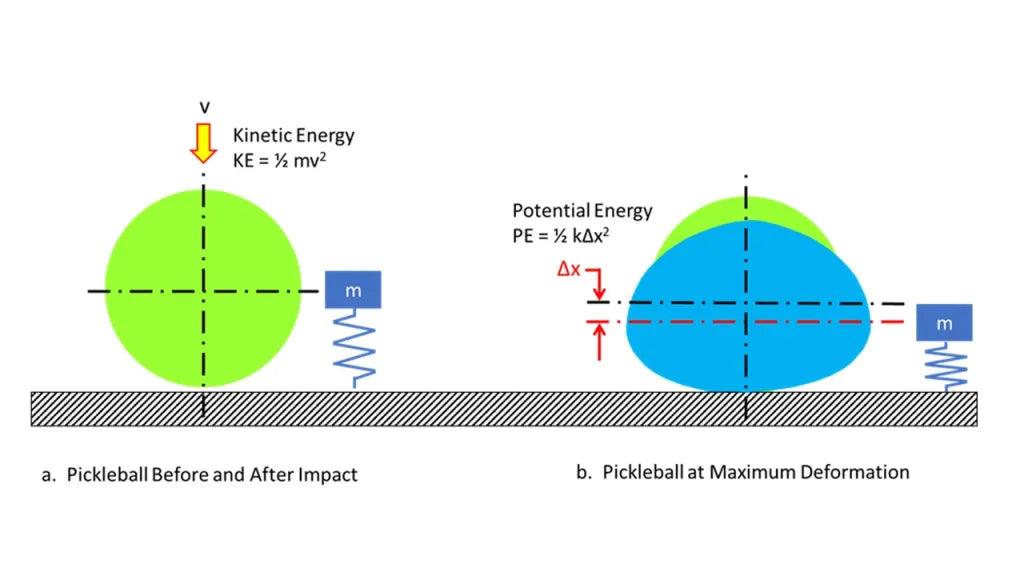
ANTI-CoR
|
|
|
Time to read 3 min
|
|
|
Time to read 3 min
Let’s analyze the current state of pickleball and focus on a key issue: ball speed. If ball speed is becoming a concern, the logical first step is to identify why the ball is flying faster. There is no conclusive evidence that paddles are becoming more elastic, nor that paddles are breaking down into something more elastic while still providing consistent performance. This notion remains speculative.
At present, all we can definitively say is that the ball is moving faster, but there is no direct evidence to suggest that increased paddle elasticity is the primary cause. Instead, it seems plausible that paddles are able to exert more force on the pickleball, leading to faster displacement of the ball.
Coefficient of Restitution (CoR) and Elasticity
The coefficient of restitution, or CoR, is a material-based metric that quantifies how much kinetic energy remains after a collision. The USAPA has not provided any substantial research into whether paddle elasticity plays a significant role in the increase of ball speed before attempting to regulate it. Misunderstandings of CoR extend to players and manufacturers alike.
In an elastic collision, the CoR approaches 1, meaning the ball and paddle retain most of their kinetic energy. In an inelastic collision, the CoR approaches zero, meaning more energy is lost to deformation, sound, or heat.
If the paddle is rigid and the ball deforms significantly upon impact, the CoR measures the combined elastic properties of both the paddle and the ball. In a scenario where a rigid paddle causes more deformation in the ball, more energy is transferred into the ball’s speed rather than being lost to deformation in the paddle.
Elasticity and Ball Deformation
If the paddle were elastic and deformed more upon impact, CoR would reflect this by indicating a lower energy transfer to the ball due to internal energy losses in the paddle material. This is why an elastic paddle may fail CoR tests if it absorbs too much energy. Conversely, a rigid paddle might pass CoR be considered as transferring too MUCH energy to the ball if the USAPA chooses to wrongly associate this metric with ball velocity. We also should be studying how pickleballs are performing under impact conditions of higher power paddles vs lower power paddles.
It's possible that paddles have just evolved beyond the ball. So now do we strangle innovation and diversity in paddles which is very much part of the spirit of this sport or do we consider how the ball can be modernized? Is the sport even capable of considering modernizing the ball after the last fiasco? We should be, we are very capable of creating a much better and contextually appropriate ball.
Look at the paddles were playing with, then look at the ball... It's pretty simple.
Questioning the Impact of Ball Speed on the Sport
The argument that increased ball speed is a problem for the average recreational player is debatable. For many, ball speed is not the limiting factor in their game. Yet, the USAPA seems focused on regulating the paddle industry under the pretext of controlling ball speed, which risks stifling innovation, particularly among smaller manufacturers. It is important to note that many smaller manufacturers source materials from the same suppliers as larger brands, suggesting that concerns about quality control are overblown.
Moreover, the recent decertifications of paddles have disproportionately affected larger brands, not smaller ones like CoreTek Pickleball, whose paddles remain USAPA certified and free from elastic components. Our paddles are designed for rigidity, and we do not claim any elasticity benefits.
The Science Behind Paddle Regulation
The CoR is a measure of the combined elastic properties of a system during a collision, encompassing both the paddle and the ball. If paddle elasticity were the root issue, CoR testing would easily flag elastic paddles. However, rigid paddles that transfer more energy to the ball—by causing greater ball deformation—could also be selected against, even if their design aligns with USAPA standards. This creates a paradox where paddles designed to be rigid may still be penalized for enhancing ball speed.
At CoreTek Pickleball, we stand by our products and challenge any regulatory body that attempts to unjustly restrict innovation based on flawed rationale. The focus should be on the actual impact of ball speed in matches, not on imposing restrictive material standards that may have little effect on recreational play.
It's also important to note that Pickleball has developed a culture of blame the paddle, especially in higher level play. You'll here players demand their opponents paddle be tested, but not give a thought to the ball. These people play for Joola and Selkirk for reason. They are essentially employees. Either way, it suits their bosses. It has been wrongly suggested and proposed as desirable to play with worn pickleballs as some believe that play will rough the surface and enable them to somehow grip the paddle face which is not going to happen ever.
So I asked you do we not have as much of a cultural problem as a material problem if not more?